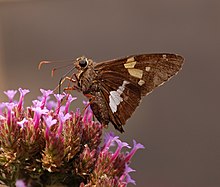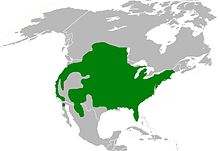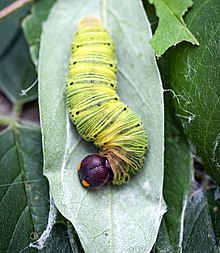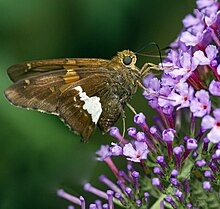| Silver-spotted skipper | |
|---|---|

| |
| Scientific classification | |
| Domain: | Eukaryota |
| Kingdom: | Animalia |
| Phylum: | Arthropoda |
| Class: | Insecta |
| Order: | Lepidoptera |
| Family: | Hesperiidae |
| Genus: | Epargyreus |
| Species: | E. clarus
|
| Binomial name | |
| Epargyreus clarus (Cramer, 1775)
| |

| |
| Synonyms | |
| |
Epargyreus clarus, the silver-spotted skipper, is a butterfly of the family Hesperiidae. It is claimed to be the most recognized skipper in North America.[2] E. clarus occurs in fields, gardens, and at forest edges and ranges from southern Canada throughout most of the United States to northern Mexico, but is absent in the Great Basin and western Texas.[3]
E. clarus larvae create and reside in unique shelters stuck together with silk, which do not protect them from predators.[4] Natural predators of the species include paper wasp foragers, sphecid wasp and Crematogaster opuntiae ants.[5][6] The species is also considered to be a perching species, meaning that adult males compete for territory to attract females.[7] Although E. clarus is considered to be a pest of a few crop plants such as beans, its pest activity is not serious enough to warrant initiating major control measures.[5]


- ^ "NatureServe Explorer 2.0 Epargyreus clarus Silver-spotted Skipper". explorer.natureserve.org. Retrieved 1 October 2020.
- ^ Kaufman, Kenn; Eaton, Eric R. (2007). Kaufman Field Guide to Insects of North America. Houghton Mifflin Books. pp. 236–237. ISBN 978-0-618-15310-7.
- ^ "Silver-spotted skipper". Butterflies and Moths of North America. Archived from the original on 2009-01-16. Retrieved 2008-10-11.
- ^ Cite error: The named reference
:3was invoked but never defined (see the help page). - ^ a b Cite error: The named reference
:2was invoked but never defined (see the help page). - ^ Cite error: The named reference
:4was invoked but never defined (see the help page). - ^ Scott, James A. (1974). "Mate-Locating Behavior of Butterflies". The American Midland Naturalist. 91 (1): 103–117. doi:10.2307/2424514. JSTOR 2424514.
